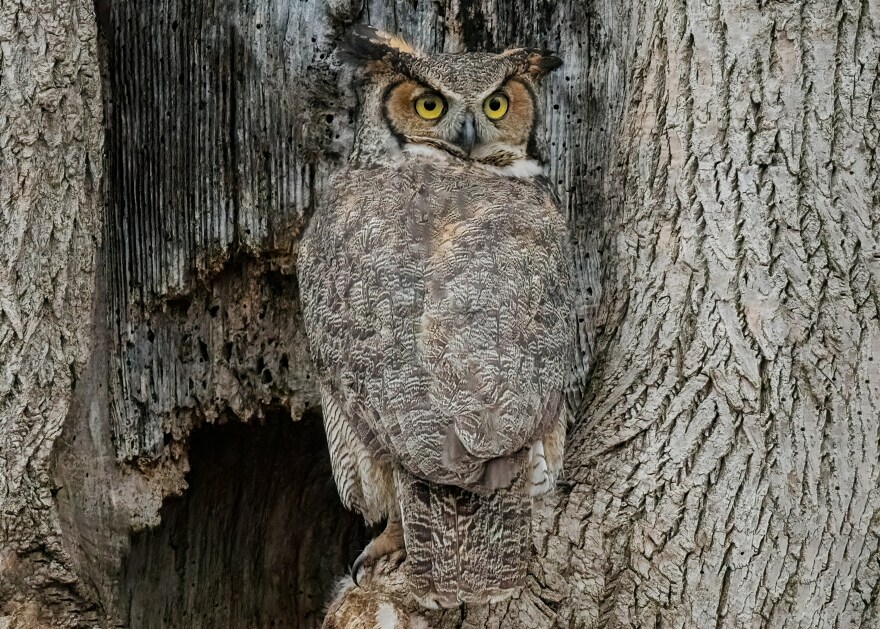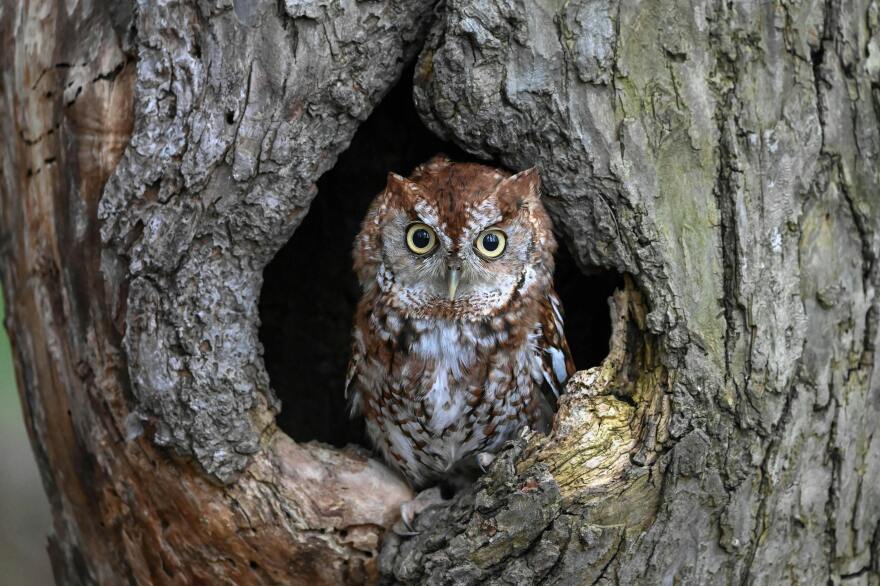Have you ever been on an owl prowl?
It’s a nighttime hike in the woods where you listen for the calls, shrieks and whistles of owls to help you get a glimpse of them.
For this month’s Chirp Chat, Lake Effect’s Xcaret Nuñez spoke with Mary Holleback, Nathaniel Reinartz and John O’Donnell at the Riveredge Nature Center.
Holleback is Riveredge's Citizen Science Manager, and Reinartz is its Conservation Manager. O’Donnell is an avid birder and involved with Friends of the Cedarburg Bog.
They each lead annual owl prowls in the Saukville area and explain how people can see and hear owls around this time of year and into winter.
What makes owls different from other raptors?
O’Donnell and Reinartz say owls have three defining characteristics:
- Keen eyesight: Owl eyes aren’t truly eyeball-shaped, they’re more tube-shaped. Their facing-forward eyes are immovable, which helps give them binocular vision to fully focus on their prey. Owls compensate for their immobile eyes with their ability to rotate their heads 270 degrees. Owls also have excellent vision both in daylight and at night.
- Silent flight: The feathers of an owl are softly fringed along the edge of their wings. This trait makes owls glide soundlessly in flight, which helps them go unnoticed by prey.
- Sharp hearing: Many owls have asymmetrical ears, which means their left ear is slightly lower than their right ear. By angling their head, this trait helps owls pinpoint the exact location of where a sound is coming from.

Owl prowl tips
When to go: Although some owl species can be found year-round in Southeast Wisconsin, the best time to spot owls is October through December, when most owls are establishing territories. You can also go on owl prowls from January through April, when most owls are more vocal and breeding.
What time to go: It’s also encouraged to go out at dusk on a moonlit night. You’ll have a better chance of spotting the silhouette of a moonlit owl than you might with a flashlight’s bright light. If you do want to bring a flashlight, Holleback recommends covering the light with red cellophane to avoid hurting your vision or an animal’s.
Where to go: Go on owl prowls at nature trails you’re most familiar with and bring a friend. O’Donnell says it helps to go on guided owl prowls hosted by birding groups like the Ozaukee-Washington Birding Coalition.
What to wear: Dress for the weather. It’ll be cold outside, so make sure to layer up and wear comfortable hiking shoes or snow boots.
Be respectful: Speak in whispers and walk as quietly as you can. Talking out loud and stomping will spook owls away. Holleback also recommends that birders avoid playing owl calls once owls have nested (January through April) to avoid pulling them away from their eggs or fledglings and risking another owl taking over their territory.

Common owls in Wisconsin
Great horned owls are the largest and most common owl that can be found in Wisconsin. Holleback says they’re the first owls to start nesting in the state and “by the end of January, they're laying their first egg… so it’s important to be respectful and wise about when these birds are nesting. That's why doing an owl prowl at this time of the year isn't as [risky] — you’re not drawing a bird away from its nest by playing recordings.”
You’ll most likely spot barred owls in trees near wetlands and rivers. Holleback says they start to set up territories and find mates in February and March. She also says they tend to nest in old tree cavities.
Eastern screech owls are a small owl species that can be found in the state. The feather tufts on top of their heads make them easily identifiable. Holleback says eastern screech owls start to set up territories and find mates between February and March, similar to the barred owl. They also tend to nest in old tree cavities.
Chirp Chat’s Bird of the Month for October

Reinartz says the northern saw-whet owl is the smallest owl in Wisconsin. “It's not much bigger than a soda can… and it's got a little round, spherical head with eyes taking over much of its face with bright yellow irises.”
Reinartz says the northern saw-whet owl gets its name from its call, which sounds like a saw being sharpened on a whetting stone. “They do a rising screech, and then they also do a territorial advertisement that is a consistent tooting like, ‘Toot, toot, toot’ … that sound really stands out in the woods at night, and you're not going to mistake it for another owl.”
Some of the owl calls you hear in this episode of Chirp Chat were recorded and provided by Nathaniel Reinartz, Conservation Manager at Riveredge Nature Center.







